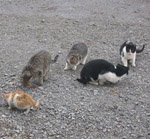Identifying minimum patch sizes for breeding success in birds
 Birds
Birds  Golden-cheeked warbler (Dendroica chrysoparia). Image credit, Steve Maslowski.A new study illustrates the importance of understanding the minimum patch size that an at-risk bird needs to reproduce. Jerrod Butcher and fellow researchers from Texas A&M University looked at the effect of habitat patch size on two songbirds in north-central Texas.
Golden-cheeked warbler (Dendroica chrysoparia). Image credit, Steve Maslowski.A new study illustrates the importance of understanding the minimum patch size that an at-risk bird needs to reproduce. Jerrod Butcher and fellow researchers from Texas A&M University looked at the effect of habitat patch size on two songbirds in north-central Texas.
For the federally endangered golden-cheeked warbler, they found that birds did not successfully breed in patches smaller than 15-20 hectares indicating that a threshold exists at that size below which the birds do not reproduce. However, the study also found that the warblers established territories in patch sizes as small as 2.9 hectares (the smallest studied) and paired in patches as small as 4.1 hectares.
From a conservation perspective, this study shows that research looking at just the presence-absence of the warblers (or even bird pairings) would substantially underestimate the minimum habitat patch size needed to sustain a viable population.
The researchers also looked at white-eyed vireos, a habitat generalist, and as predicted found no evidence of a minimum patch size threshold for breeding success - the vireos successfully reproduced in patches as small as 4.1 hectares.
One of the benefits of identifying patch size thresholds is that by looking at how different environmental variables change when you cross the threshold, you can get clues on what factors are influencing the bird behavior. In this vein, the researchers looked at two variables along the patch size gradient: 1) brown-headed cowbird parasitism; and 2) abundance of arthropods - the food source for the birds.
However, the researchers found no relationship between either variable and patch size, which means they likely are not explanations for the threshold. So more research is needed to figure out why golden-cheeked warblers do not breed in patches smaller than 15-20 hectares.
This study also raises the issue of whether small patches act as ecological traps for the golden-cheeked warblers resulting in population sinks that further threaten the species. This could occur if small patches are attractive to the warblers leading to numerous small territories where the birds are not able to reproduce. However, the study authors warn against jumping to that conclusion. They write,
"Patches of habitat <20 hectares in area may not be large enough to sustain a viable population of golden-cheeked warbler in the long-term; however, such patches may benefit populations if the patches can sustain breeding pairs in the short term."
Nevertheless, they advise that managers across the distribution range of golden-cheeked warbler be cautious about decreasing vegetation patches below 20 hectares. Similar research on minimum patch-size thresholds for breeding success could be important for the conservation of other at-risk birds.
--Reviewed by Rob Goldstein
Butcher, J., Morrison, M., Ransom, D., Slack, R., & Wilkins, R. (2010). Evidence of a Minimum Patch Size Threshold of Reproductive Success in an Endangered Songbird Journal of Wildlife Management, 74 (1), 133-139 DOI: 10.2193/2008-533




Reader Comments